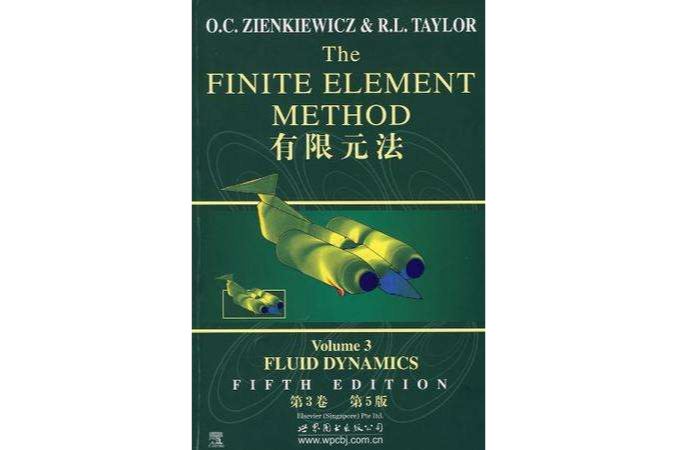《有限元法(第3卷)》是2005年世界圖書出版公司出版的圖書,作者是R.L.Taylor。
基本介紹
- 中文名:有限元法(第3卷)
- 作者:R.L.Taylor
- 出版社:世界圖書出版公司
- 出版時間:2005年4月
- 頁數:334 頁
- 定價:56 元
- 裝幀:簡裝本
- ISBN:9787506265492

《有限元法(第3卷)》是2005年世界圖書出版公司出版的圖書,作者是R.L.Taylor。
《有限元法(第3卷)》是2005年世界圖書出版公司出版的圖書,作者是R.L.Taylor。內容簡介這是一套在國際上頗具權威性的經典著作(共3卷),由有限元法的創始人zienkiewicz教授和美國加州大學TayIor教授...
《有限元方法(第5版)第3卷流體動力學》是2008年出版的書籍,作者是符松。內容簡介 《有限元方法》一書涵蓋了有限元的基本方法,以及這一方法在固體和結構力學、流體動力學問題中的套用。第1卷完整地介紹了有限元方法的基礎知識,適於本科生、研究生以及專業工程師學習。第2卷集中介紹了有限元方法在非線性固體和...
有限元法 《有限元法》是西南交通大學出版社出版的圖書,作者是榮先成主編
《有限元方法》是由清華大學出版社於2008年7月1日出版的圖書,該書作者是曾攀。該書為有限元方法系列專著的第1卷——基本原理,涵蓋了有限元分析的一些基礎領域,同時還涉足有限元分析的前沿內容。內容簡介 該卷共20章,內容廣泛,既強調有限元的數學力學原理,又結合工程實際背景。該書的第1版完成於1967年,到...
《有限元法:理論、格式與求解方法》是2016年高等教育出版社出版的圖書,作者是巴特 (Klaus-Jürgen Bathe)。內容簡介 有限元法是當今工程分析和科學研究不可或缺的方法。有限元法在科學計算領域不僅實用,而且高效,套用廣泛。本書是Finite Element Procedures.2nd edition的中文版,原著是一本經典的、具有顯著深度和...
在數學中,有限元法(FEM,Finite Element Method)是一種為求解偏微分方程邊值問題近似解的數值技術。求解時對整個問題區域進行分解,每個子區域都成為簡單的部分,這種簡單部分就稱作有限元。它通過變分方法,使得誤差函式達到最小值並產生穩定解。類比於連線多段微小直線逼近圓的思想,有限元法包含了一切可能的方法,...
《ANSYS有限元基礎教程(第3版)》是2019年電子工業出版社出版的圖書,作者是王新榮。內容簡介 本書介紹有限元法的基本原理、ANSYS軟體的功能及操作、套用實例,堅持理論與實踐的結合,強調實用性和可操作性。全書分為三部分,第一部分由第1~4章組成,介紹有限元法的基本原理和分析過程;第二部分由第5~9章組成,...
《有限元方法(英文版)》是2013年科學出版社出版的圖書,作者是石鐘慈、王鳴 。內容簡介 本書系統地論述了有限元方法的數學基礎理論,以橢圓偏微分方程邊值問題為例,介紹了協調有限元方法以及非協調等非標準有限元方法的數學描述、收斂條件和性質、有限元解的先驗和後驗誤差估計以及有限元空間的基本性質,其中包括...
10 解題步驟與算例第3章 高次單元與等參單元3.1 概述3.2 四節點平面矩形單元3.3 六節點三角形單元3.4 平面四節點四邊形等參元3.5 等參單元的一般概念3.6 八節點曲線四邊形等參元3.7 八節點六面體等參元3.8 20節點立體等參元3.9 幾種單元的套用實例及對比第4章 板殼問題有限元法4.1 ...
第三步 後處理: 對所求出的解根據有關準則進行分析和評價。後處理使用戶能簡便提取信息,了解計算結果。基本特點 有限元方法與其他求解邊值問題近似方法的根本區別在於它的近似性僅限於相對小的子域中。20世紀60年代初首次提出結構力學計算有限元概念的克拉夫(Clough)教授形象地將其描繪為:“有限元法=Rayleigh ...
《有限元方法及其套用(英文版)》是2014年科學出版社出版的圖書,作者是Kaitai Li, Aixiang Huang, Qinghuai Huang。內容簡介 本書內容包括: 有限元方法構造及其在電子計算機實現的全過程, 橢圓邊值問題變分原理, 有限元解的收斂性, 非標準有限元方法, 以及有限元方法在科學與工程中的套用, 並且介紹了作者幾年來...
得到具有較好指出, 將出現以隨機變分原理為基礎的隨機有限元法來逐漸取代以攝動法為基礎的隨機有限元法。 Spanos和Ghanem等人 (1989, 1991) 結合隨機場函式的Karhuen-Loeve展式和Galerkin(迦遼金)射影方法建立了相應的隨機有限元列式,並撰寫了隨機有限元法領域的第一本專著《隨機有限元譜方法》 。
第一章 一些預備知識:標準的離散系統 第二章 彈性連續體的有限元——位移法 第三章 有限元概念的一般化——加權余值法與變分法 第四章 平面應力與平面應變 第五章 軸對稱應力分析 第六章 三維應力分析 第七章 單元形狀函式-C0連續性的一些一般族 第八章 曲的等參數單元及數值積分 第九章 等參數單元在二維...
《有限元(第3版)》是2012年世界圖書出版公司出版的圖書,作者是布拉艾斯。內容摘要 This definitive introduction to finite element methods hasbeen thoroughly updated for this third edition, which featuresimportant new material for both research and application of thefinite element method.The discussion of ...
3.2.1 位移函式 3.2.2 應變與應力矩陣 3.2.3 單元剛度矩陣 3.2.4 算例 3.3 平面等參元 3.3.1 等參元剛度矩陣 3.3.2 算例 3.4 平面單元套用比較分析 3.4.1 低階元與高階元簡介 3.4.2 選用單元的一般原則 3.4.3 算例 3.4.4 提高計算精度的途徑 小結 習題 第四章 桿件系統有限元法 ...
《有限元法及ANSYS程式套用基礎》內容由淺入深.主次分明,通俗易懂,便於自學。《有限元法及ANSYS程式套用基礎》可作為高等院校工科專業本科生和研究生教材,也可供有關專業工程技術人員參考和使用。圖書目錄 前言 第1章 緒論 第2章 有限元法的直接剛度法 第3章 彈性力學基礎知識 第4章 平面問題的有限元法 第5...
本手冊基本概念清晰,套用性強,附有大量參考文獻,可供有關的科學、技術工作者及大專院校師生閱讀、參考。圖書目錄 中譯本序 作者一覽表 序言 致謝 目錄 第一篇 有限元法數學 F.Brezzi 第二篇 有限元法基礎 S.N.Atluri 第三篇 有限元法套用 D.H.Norrie 第四篇 有限元法計算 W.D.Pilkey 索引 ...
3、該教材在相關章節的習題中給出了程式設計作業,要求讀者結合所學理論知識,編寫電腦程式以加深對有限元方法的理解。4、該教材注重講解實際套用時如何建立合理的有限元模型,如何選擇單元,如何判斷和保證計算精度,如何分析計算結果等。5、該教材適合於有限元理論學習、上機編程實踐以及利用商用有限元軟體分析科學研究...
《有限元方法及其套用》是2006年科學出版社出版的圖書,作者是李開泰、黃艾香、黃慶懷。內容簡介 本書內容包括:有限元方法構造及其在電子計算機實現全過程;橢圓邊值問題變分原理;有限元解的收斂性和非標準有限元方法等。圖書目錄 第1章 有限元方法構造 第2章 單元及形狀函式 第3章 有限元方法解題過程 第4章 ...
有限元方法基礎理論 《有限元方法基礎理論》是世界圖書出版公司北京公司出版的圖書,作者是(英)監凱維奇(Zienkiewicz,O.C.)。
變形後物體的形狀,通過在離散區間上對速度積分而獲得,從而避免了有限變形中的幾何非線性問題,同時可用比彈塑性有限元大的增量步長,來達到減少計算時間,提高計算效率,並能保證足夠的精度。這就是剛塑性有限元法(Rigid-Plastic Finite Element Method)。定義 在大變形的金屬成型中,彈性變形部分比起塑性變形部分很...
《穩定廣義有限元法的研究與若干典型工程套用》是依託中山大學,由張慶輝擔任項目負責人的面上項目。中文摘要 廣義有限元法(GFEM)和拓展有限元法(XFEM)是最近二十多年新興的數值模擬技術。兩者可以用單元分解(PU)的概念統一起來,只是在整體或局部富集上有差別,文中統一用GFEM來代替二者。GFEM對規則格線上的...
1.9 勢能與平衡方程,Rayleigh?Ritz法 1.10 Galerkin方法 1.11 聖維南原理 1.12 von Mises應力 1.13 電腦程式 1.14 小結 有限元發展過程的參考文獻 習題 第2章 矩陣代數與高斯消元法 2.1 矩陣代數 2.2 高斯消元法 2.3 方程求解的共軛梯度法 習題 程式清單 第3章 一維問題 3.1 概述 3.2 建立...
馮康(1920年9月9日-1993年8月17日),浙江紹興人,出生於江蘇省南京市,數學家、中國有限元法創始人、計算數學研究的奠基人和開拓者,中國科學院院士,中國科學院計算中心創始人、研究員、博士生導師。1944年馮康畢業於國立中央大學;1945年在復旦大學數學物理系擔任助教;1946年到清華大學任物理系助教;1951年轉任...
